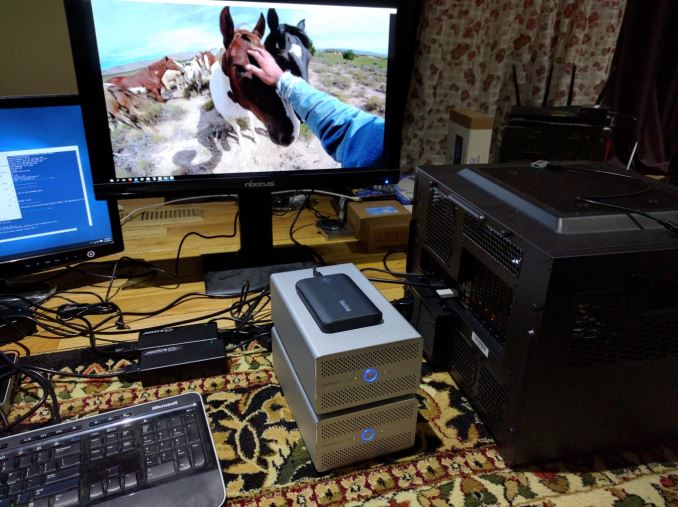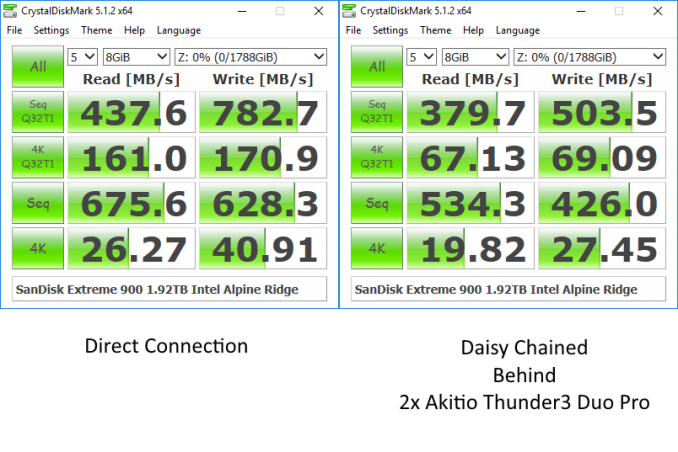Thunderbolt 3 in Action: Akitio Thunder3 Duo Pro DAS Review
by Ganesh T S on April 14, 2016 8:30 AM EST- Posted in
- Storage
- DAS
- Thunderbolt 3
- Akitio
Daisy Chaining
The full capabilities of Thunderbolt 3 are brought out when we have a series of devices hooked up in a daisy chain fashion to the testbed. Thunderbolt has always supported DisplayPort monitors at the end of a daisy chain. With Thunderbolt 3, any USB device with a Type-C interface can terminate the chain. The design of the Akitio Thunder3 Duo Pro ensures that a DisplayPort monitor does not need to be a link in the daisy chain, but can hang off as a node. We performed some testing with the following daisy chain configuration:
- AnandTech Skylake DAS Testbed with 2x Thunderbolt 3 (TB3) ports
- TB3 Port 1 of testbed connected to TB3 Port 1 of Akitio Thunder3 Duo Pro A
- TB3 Port 2 of Thunder3 Duo Pro A connected to TB3 Port 1 of Thunder3 Duo Pro B
- Nixeus Vue-27D 2560x1440 DisplayPort monitor connected to DisplayPort output of Thunder3 Duo Pro B
- SanDisk Extreme 900 1.92TB connected to TB3 Port 2 of Thunder3 Duo Pro B
The daisy chain setup is brought out in the photograph below.
IOMeter is one of the most reliable tools to measure performance while accessing multiple storage nodes simultaneously. In order to get maximum performance, we set up the two Akitio Thunder3 Duo Pro units in JBOD mode. Including the SanDisk Extreme 900, we ended up with five different physical disks that could be accessed over the single Thunderbolt 3 link. We ran the standard 128K sequential accesses with a queue depth of 4 and the 4K random accesses with a queue depth of 32. The table below shows the bandwidth realized as a function of the number of disks accessed simultaneously.
| 2x Akitio Thunder3 Duo Pro with 4x Intel SSD DC S3510 + SanDisk Extreme 900 (Thunderbolt 3 + USB 3.1 Gen 2 Daisy Chaining) IOMeter Benchmarks (MBps) |
||||
| Number of Simultaneous Disk Accesses | Write Bandwidth | Read Bandwidth | ||
| 128K Seq QD4 | 4K Rand QD32 | 128K Seq QD4 | 4K Rand QD32 | |
| 1 | 243.30 | 45.39 | 334.51 | 226.95 |
| 2 | 508.89 | 198.69 | 671.14 | 178.00 |
| 3 | 749.80 | 199.19 | 943.28 | 159.88 |
| 4 | 1010.37 | 160.12 | 1229.20 | 131.81 |
| 5 | 1489.72 | 172.68 | 1761.13 | 153.85 |
The sequential access numbers show that the link is nowhere near getting saturated despite pushing across more than 1700MBps (not accounting for the DisplayPort bandwidth here). However, with two bay devices supporting only SATA drives, it is difficult to sustain more traffic than what we have recorded here. That said, as more peripherals start coming out (in the form of docks or even units with 10+ drive bays), Thunderbolt 3 can show its true benefits.
Performance Implications
Daisy chaining is a nifty feature, but users must realize that as one goes further down the chain, the performance of the peripheral decreases. We studied this aspect further by using the SanDisk Extreme 900 USB 3.1 Gen 2 Portable SSD. In our first test, we connected the portable SSD directly to the Thunderbolt 3 port of the testbed. CrystalDiskMark was run with Alpine Ridge acting as a pure USB 3.1 Gen 2 host. In the second test, we connected the portable SSD to the free Thunderbolt 3 port on the Thunder3 Duo Pro that was farthest from the testbed (in the configuration mentioned at the top of this section).
The numbers clearly show a significant drop in performance as the peripheral gets further and further away from the main system. Similar drop in performance was noted for ATTO and all our real-life benchmarks (robocopy and PCMark 8 storage bench) also.












60 Comments
View All Comments
DanNeely - Thursday, April 14, 2016 - link
Were there any issues with video quality/reliability in your daisy chaining test?I'm guessing not since you didn't come close to saturating the bus in this test, but I'd be really interested in seeing what happens if you ever get to play with something like a 10bay SSD enclosure and external GPU that could devour most of the bandwidth for what ever they're running.
ganeshts - Thursday, April 14, 2016 - link
The DisplayPort lanes are muxed together with the PCIe lanes, and, if any throttling were to happen, it would be on the PCIe lanes, and not the DisplayPort ones.But, yes, we were way short of saturating the link because we were not equipped properly to test that aspect.
DanNeely - Thursday, April 14, 2016 - link
Ok. I didn't know the DP lanes were given explicit preference in the MUXing; but I suppose that in general it's probably the right way to go.repoman27 - Thursday, April 14, 2016 - link
I just wanted to clarify that Thunderbolt supports multiple signaling modes over a single port via hardware muxing, however, when operating in Thunderbolt signaling mode, it uses protocol converters and crossbar switches to mux at the packet level. So the Thunderbolt mode is more like iSCSI or other technologies that encapsulate and transport data streams over IP networks alongside other packets. The encapsulation that Thunderbolt performs is incredibly lightweight, though, and Intel even refers to it as a "meta protocol".Thunderbolt seems to have fairly solid mechanisms in place for guaranteeing timely delivery of packets that are part of isochronous data streams such as DisplayPort. OG Thunderbolt did have some issues with USB audio adapters, as it had no way of knowing that the PCIe packets destined for the USB host controller in the device were particularly time sensitive.
Bear in mind that the signaling rate of a Thunderbolt PHY is considerably higher than the versions of PCIe or DisplayPort that it's carrying. Also, it can strip out all the bit-stuffing that is normally used to maintain a constant DisplayPort data rate and just send the packets carrying actual data. Or it can essentially bit-stuff with PCIe packets instead.
And one last niggle, Thunderbolt cables are really nothing like regular DisplayPort cables aside from sharing the miniDP connector. They're active and have four full-duplex signaling lanes, whereas DP cables are generally passive and only support half-duplex lanes for the main link.
DanNeely - Friday, April 15, 2016 - link
You say USB Audio was a problem with the original generation, does that mean it's not a problem in the 2nd/3rd generation? If so, how was it fixed: Throwing more bandwidth at the problem, or by doing usb packet inspection to ID and prioritize the usb audio stream?Also, am I right in assuming a TB dock with audio out would be using a built in usb audio device?
repoman27 - Saturday, April 16, 2016 - link
Here's Anand's description of the original problem: http://www.anandtech.com/show/4832/the-apple-thund...Honestly, I have no idea if the issue with the Promise Pegasus R6 drives (one of the very first Thunderbolt devices to make it to market) was ever fully resolved. In the meantime, Apple has released updates to their EFI, Thunderbolt host, device and cable firmware (yup, even the cables have firmware), and USB host controller and audio device drivers. If I had to guess, making the USB host controller / audio device drivers Thunderbolt aware and capable of isochronous bandwidth reservation (a la FireWire) might have solved the problem. However, Anand's conclusions about the root cause are different than mine, so I could be way off base.
And yes, AFAIK Thunderbolt docks all use USB devices in some form or another for audio I/O.
danbob999 - Thursday, April 14, 2016 - link
"the street price of $378 sounds reasonable"Sorry but no, a hard drive case is not worth $378. Wake me up when it cost less than $30.
NCM - Thursday, April 14, 2016 - link
On the off chance that you're just ignorant, not a troll, I'll point out that it's not a "hard drive case." This enclosure holds two drives, it provides a selection of hardware RAID options, and it has very high speed connectivity via Thunderbolt 3. It's also one of the first products of of it kind. Each one of those things adds cost.Yes it's not cheap, but this kind of product will become less expensive over time. For comparison purposes we have a bunch of 2.5" drive RAID enclosures at the office that run about $270 each (empty), see http://www.bhphotovideo.com/c/product/882789-REG/C...
danbob999 - Thursday, April 14, 2016 - link
This is a 2x3.5" case. It's too bulky to be useful for 2.5" SSDs. It's too expensive and no faster and a plain USB3 case when you put two 3.5" HDDs.I wasn't trolling, I seriously don't see any use case for it. The fact that it needs a fan to operate just make it worse.
Guspaz - Thursday, April 14, 2016 - link
Can you point out a 2x3.5" USB 3 hard drive enclosure with hardware RAID support for under $30? I get that you think $378 is too much, but $30 seems far more unreasonable a price than $378.